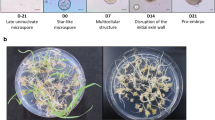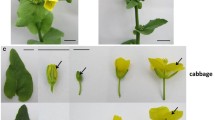Abstract
In order to understand the occurrence of albinism during androgenesis in barley, a number of plastid parameters were analyzed in microspore-derived embryos and androgenetic plantlets, and the results were compared in albino and non-albino producing cultivars. In the winter cv. Igri, plastids in microspore-derived embryos are characterized by numerous divisions, differentiated thylakoids, low amount of starch and a high DNA content examined by immunoelectron microscopy. After regeneration, the androgenetic plantlets were mostly chlorophyllous. In contrast, in the spring lines tested, the plastids of microspore-derived embryos were rarely dividing amyloplasts in which thylakoids and DNA were scarce and albino plantlets were mainly regenerated. After 2 weeks on the regeneration medium, plastids of Igri chlorophyllous androgenetic plantlets were typical chloroplasts, whereas in spring lines plastids of albino androgenetic plantlets were proplastids with the same characteristics as those in the corresponding microspore-derived embryos. These results strongly suggest that the origin of androgenetic albinism differs in winter and spring cvs.: in the winter cv. Igri plastid alteration may take place during the regeneration step of androgenesis whereas in the tested spring lines plastids are already affected in the microspore-derived embryos meaning that albinism is not initiated during regeneration but originates earlier during the androgenetic process likely as early as the sampling stage.
Similar content being viewed by others
References
Cai Q, Szarejko I, Polok K &; Maluszynski M (1992) The effect of sugars and growth regulators on embryoid formation and plant regeneration from barley anther culture. Plant Breed 109: 218–226
Caredda S &; Clément C (1999) Androgenesis and albinism in Poaceae: influence of genotype and carbohydrates. In: Clément C, Pacini E &; Audran JC (eds) Anther and Pollen: From Biology to Biotechnology (pp. 211–228). Springer, Berlin, Heidelberg, Tokyo
Caredda S, Devaux P, Sangwan RS &; Clément C (1999) Differen-tial development of plastids during microspore embryogenesis in culbarley. Protoplasma 208: 248–256
Caredda S, Devaux P, Sangwan RS &; Clément C (2000) Plastid differentiation during androgenesis in albino and non-albino producing cultivars of barley (Hordeum vulgare L.). Sex. Plant Reprod. 13: 95–104
Cistué L, Ramos A, Castillo AM &; Romagosa I (1994) Production of large number of doubled haploid plants from barley anthers pretreated with high concentrations of mannitol. Plant Cell. Rep. 13: 709–712
Cistué L, Ramos A &; Castillo AM (1999) Influence of anther pretreatment and culture medium composition on the production of barley doubled haploids from model and low responding cultivars. Plant Cell. Tiss. Org. Cult. 55: 159–166
Devaux P, Zivy M, Kilian A &; Kleinhofs A (1996) Doubled haploids in barley. In: Scoles G &; Rossnagel B (eds) V Int Oat Conf and VII Int Barley Genet Symp (pp. 213–222). University Extenson Press, Saskatoon, Saskatchewan, Canada
Dunford RP &; Walden RM (1991) Plastid genome structure and plastid-related transcript levels in albino barley plants derived from anther culture. Curr. Genet. 20: 339–347
Finnie SJ, Powell W &; Dyer AF (1989) The effect of carbohydrate composition and concentration on anther culture response in barley (Hordeum vulgare L.). Plant Breed 103: 110–118
Jähne A &; Lörz H (1995) Cereal microspore culture. Plant Sci. 109: 1–12
Jähne A, Lazzeri PA, Jäger-Gussen M &; Lörz H (1991) Plant regeneration from embryogenic cell suspensions derived from anther cultures of barley (Hordeum vulgare L.). Theor. Appl. Genet. 82: 74–80
Knudsen S, Due IK &; Anderson SB (1989) Components of response in barley anther culture. Plant Breed 103: 241–246
Larsen ET, Tuvesson IKD &; Andersen SB (1991) Nuclear genes affecting percentage of green plants in barley (Hordeum vulgare L.) anther culture. Theor. Appl. Genet. 82: 417–420
Lichtenthaler HK (1987) Chlorophylls and carotenoids: pigments of photosynthetic biomembranes. Methods Enzymol. 148: 350–382
Nagata N, Saito C, Sakai A, Kuroiwa H &; Kuroiwa T (1999) Decrease in mitochondrial DNA and concurrent increase in plastid DNA in generative cells of Pharbitis nil during pollen development. Eur. J. Cell Biol. 78: 241–248
Nagata N, Saito C, Sakai A, Kuroiwa H &; Kuroiwa T (1999) The selective increase or decrease of organellar DNA in generative cells just after pollen mitosis one controls cytoplasmic inheritance. Planta 209: 53–65
Mogensen HL (1996) The hows and whys of cytoplasmic inheri-tance in seed plants. Am. J. Bot. 83: 383–404
Mouritzen P &; Holm PB (1994) Chloroplast genome breakdown in microspore cultures of barley (Hordeum vulgare L.) occurs primarily during regeneration. J. Plant Physiol. 144: 586–593
Olsen FL (1987) Induction of microspore embryogenesis in culbarley. tured anthers of Hordeum vulgare. The effects of ammonium nitrate, glutamine and asparagine as nitrogen sources. Carlsberg Res. Commun. 52: 393–404
Pickering RA &; Devaux P (1992) Haploid production: approaches and use in plant breeding. In: Shewry PR (ed) Barley: Genetics, Biochemistry, Molecular Biology and Biotechnology (pp. 519–547). CAB International, Oxford
Sunderland N &; Huang B (1985) Barley anther culture: the switch of programme and albinism. Hereditas Suppl. 3: 27–40
Touraev A, Vicente O &; Heberle-Bors E (1997) Initiation of microspore embryogenesis by stress. Trends Plant Sci. 2: 297–302
Wang M, van Bergen S, Lamers GEM, Oppedjik BJ &; Schilperroort RA (1999) Programmed cell death during androgenesis in Hordeum vulgare L. In: Clément C, Pacini E &; Audran JC (eds) Anther and Pollen: From Biology to Biotechnology (pp. 201–209). Springer, Berlin, Heidelberg, Tokyo
Wang M, Hoekstra S, van Bergen S, Lamers GEM, Oppedijk BJ, de Priester W &; Schilperroort RA (1999) Apoptosis in developing anthers and the role of ABA in this process during androgenesis in Hordeum vulgare L. Plant Mol. Biol. 39: 489–501
Author information
Authors and Affiliations
Corresponding author
Rights and permissions
About this article
Cite this article
Caredda, S., Devaux, P., Sangwan, R.S. et al. Plastid ultrastructure and DNA related to albinism in androgenetic embryos of various barley (Hordeum vulgare L.) cultivars. Plant Cell, Tissue and Organ Culture 76, 35–43 (2004). https://doi.org/10.1023/A:1025812621775
Issue Date:
DOI: https://doi.org/10.1023/A:1025812621775




